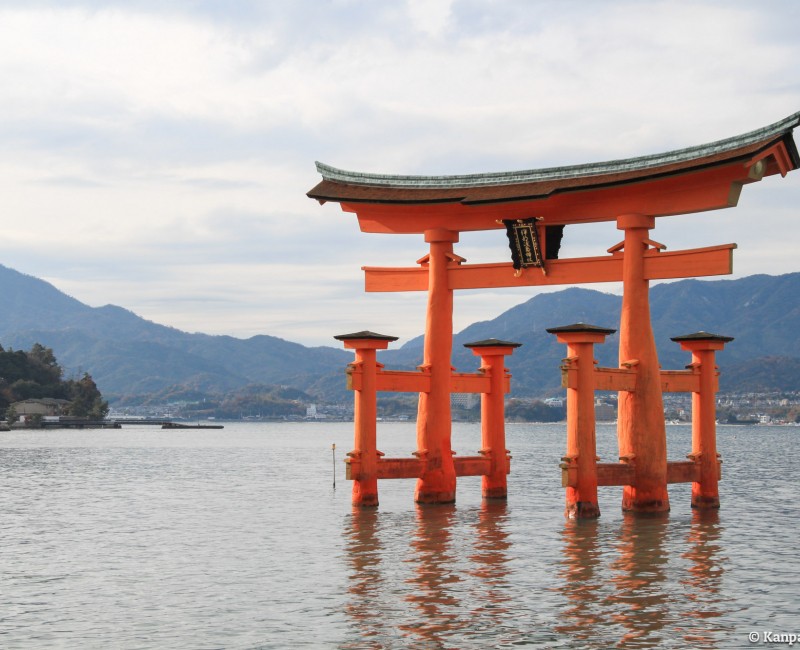Itsukushima Shrine
Itsukushima Shrine is located on the island of Itsukushima, in the Seto inland sea. The site itself has been a holy place from the 5th century, even prior to the shrine materializing later on.
Its construction started in the 6th and ended in the 12th century. The shrine's architecture talks about the amazing technical and artistic skills of all master architects involved in the project.
One notable and distinctive feature of the shrine is how it blends perfectly with the nearby sea and mountains. Its contrasting colors jump out at you and result in an unmistakable scenic allure.
As one of Japan's most popular attractions, the shrine is renowned for its artistic gate that sits on its borders. From here, visitors could observe the forest, ocean, and Mount Misen's soaring peak.
Surprisingly, you'll find 17 various structures hidden inside the complex, such as the Sessha Marodo-jinja and the Honsha shrine.
Here's my list of 8 top must-know facts about the Itsukushima Shrine.
1. It's a UNESCO World Heritage Site
Situated on Miyajima Island, more specifically, in Hiroshima Prefecture, Japan, Itsukushima Shrine has become a UNESCO World Heritage Site. It was erected on piers over the Seto Sea's water.
The shrine displays lovely colors, plus the blue sea, green forest, and the grayish tones of the admirable peaking Mount Misen.
It's regarded as one of Japan's significant Three Views along with Amanohashidate and Matsushima Island.
2. Its architecture is unique
The shrine's site is stunning. The overall artistic design of these shrines harmonizes with nature in a seamless fashion.
According to traditional Japanese architecture, the structure had to be in a natural setting, surrounded by nature, which was their standard of beauty. The work demonstrates Taira no Kiyomori's skill. Although this shrine has seen two reconstructions, it never strayed from its original style and was restored repeatedly as well.
Because of its uniqueness in architecture and cultural and religious importance, the shrine functions as a huge magnet attracting millions of visitors yearly.
3. It was extremely popular throughout the Edo era
Even prior to the shrine being raised on this sacred island, pilgrims were in the habit of coming here during the Edo era to pray mainly for the Seto Inland Sea to be safe.
However, when Taira no Kiyomori arrived to worship near the ending of the Heian period, word of mouth about the incident circulated widely and still more pilgrims visited.
Ordinary people like tradesmen and fishermen paid homage here while sailing the Seto Inland Sea. The majority of the inhabitants who resided in Japan's western region would often come to this shrine to perform their acts of worship.
4. The shrine was built in dedication to three sisters
Itsukushima Shrine was constructed in order to be dedicated to Susano-o no Mikoto's three daughters: Tagitsuhime no mikoto, Tagorihime no mikotom, and Ichikishimahime no mikoto.
These sisters are in fact three female deities and considered goddesses of storms and seas.
Taira Kiyormori held the belief that the island itself was a home to bodhisattva. Since the name Itsukushima translates island dedicated to the gods, many Japanese believed the whole island was a god.
5. Scenery surrounding the shrine changes with the tide
While the tide is high, both the shrine and the O-Torii gate seem to be gracefully floating on the water's surface. This "mirage" vanishes during low tide.
In addition, there are three ponds known as mirror ponds lying in the sand that's everywhere around the shrine.
In particular, the towering shrine, O-torii gate stands out, and also conveying the real impression of floating in the sea during high tide, it gives a marvelous experience to all fans of Japanese performing arts.
6. Common people could not visit the shrine
Not only were common people not permitted to come here, both births and deaths occurring on the island were forbidden on account of being seen as pollution. Another reason was because the whole island was regarded as being holy. So, the lack of common people here contributed largely to the island's purity. Even pregnant women were not permitted on the island! Only after giving birth could they visit the shrine.
Aging people and everyone terminally sick are always made to go to the mainland, and it's a practice that continues now. Moreover, funerals and burials are not held here.
7. The shrine's construction was inspired in a dream
Many of the shrines erected in the 16th century showcase power, excellence, and architectural beauty. The Taira who built this shrine, was engaged in maritime trade.
Legend claims that Kiyomori dreamed an old monk instructed him to erect a shrine and as compensation, he would dominate Japan.
Kiyomori paid for the shrine's construction, which was to demonstrate his reverence for the tutelary god of navigation as well as to be a base for carrying out maritime-related activities.
8. The noh stage is the only one on water in Japan located at the shrine
In the whole nation, this happens to be the only Noh stage built over water. The Mori clan gave it to the shrine during the period of the Combatant States.
The Asano clan repaired the stage during the Edo period. Urns full of water are generally put beneath the stage to enhance the sound quality. However, this isn't possible in this shrine, but its floorboards have been designed to cause a similar effect.
Most Famous Must-See Tourist Attractions in Japan




